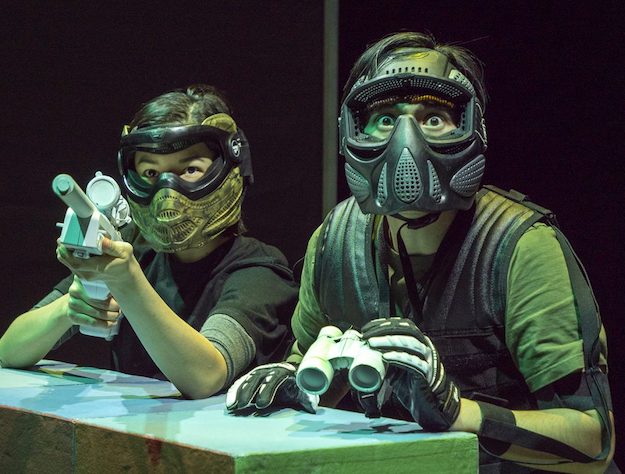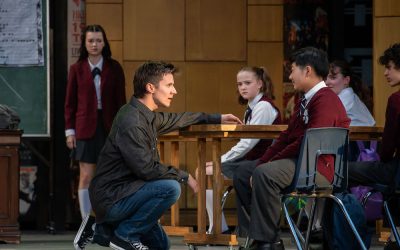
The weapons are virtual. Is the relationship real? (Photo of Kanon Hewitt and Lou Ticzon by Chris Randle)
Sure, Kim Kardashian wears great clothes, but does she have a soul? There’s a similar problem — although it’s not nearly as severe or creepy — with Kuroko: the production is stunning but, narratively and emotionally, Tetsuro Shigematsu’s script is perfunctory.
On paper, the story’s stakes look high. In the first scene, we meet a Tokyo salaryman named Hiroshi. He’s lost his job and, in one year’s time, he plans to kill himself in Japan’s Suicide Forest. But, before he dies, he wants to make sure that his 23-year-old daughter Maya is successfully launched into her adult life. That’s not going to be easy because Maya is hikikomori: she has retreated into virtual reality. In the real world, she doesn’t talk to anybody, including her parents; she hides out in her bedroom, where she spends her waking hours gaming. (According to Shigematsu’s script, there are over three million hikikomori in Japan.) Hiroshi is desperately trying to find help for Maya — and he’s got to find it soon.
Online, Maya — well, Maya’s avatar — meets the avatar of a guy named Kenzo and they start to explore the virtual universe together. But will Maya return to the real world in time to save her father from the Suicide Forest?
In terms of design, Kuroko is a knockout. Set designer Sophie Tang has created the elegant outline of a cube. And there are sheer, movable panels on a couple of the planes. So, when two sets of characters take simultaneous subway rides, for instance, projection designer Remy Siu can pour video onto those panels, showing us the blurry cityscapes and landscapes the riders are swooshing past. Lighting designer Gerald King further enriches the visuals. Costumer Christine Reimer makes tasteful realistic choices and, in the virtual world, ratchets things up — with a couple of startlingly geometric animal masks, for instance.
Director Amiel Gladstone has done a stellar job of coordinating the physical production and moving his actors around the space. There are far too many scene changes but, aided by Tang’s resourcefulness, Gladstone handles them with alacrity. And his staging of the subway sequences is an arresting combination of lyricism and wit.
The production also boasts some strong performances. John Ng, who plays Hiroshi, the dad, has a persuasively understated way of registering emotion in his body. And Lou Ticzon (Kenzo) is a gifted comedian. He gets equal comic mileage out of the weirdly inhuman movement of Kenzo’s avatar and the real-life Kenzo’s sweetly nerdy innocence. (If TV ever really discovers this guy, he could make a lot of money.)
Kanon Hewitt does just fine as Maya and her avatar, but Manami Hara is stilted in the underwritten role of Naomi, Maya’s mom. From the page on up, Naomi is a two-dimensional, interfering bag and nag with little apparent vulnerability.
The underlying problem is that Shigematsu hasn’t developed his story with any depth, so nothing matters. Maya had an older brother Ichiro, for instance, who disappeared, possibly into the Suicide Forest, when she was four and he was 15. Shigematsu presents Ichiro’s disappearance as central to the family’s dysfunction, but he provides almost no detail to back that up. We hear that Ichiro was a good baseball player, but that’s about it. How do the survivors feel about Ichiro, for God’s sake? What are their emotional and sensual memories of him? How — specifically — does his absence affect their daily lives?
Maya’s inevitable emergence from her status as hikikomori is suspiciously quick and unidirectional.
And twice Shigematsu creates opportunities for conflict and complexity, then immediately and simplistically resolves them so that the plot can continue on its mechanical way. (One situation involves mistaken identity and the other betrayal. They’re both set up but, when they should be coming to fruition, they just go poof.)
Not for one minute did I have any doubt about how this plot would end. So I just sat back and let this production register on my eyeballs.
KUROKO By Tetsuro Shigematsu. Directed by Amiel Gladstone. A Vancouver Asian Canadian Theatre production presented by The Cultch. In The Cultch’s Historic Theatre on Thursday, November 7. Continues until November 17. Tickets.
NEVER MISS A REVIEW: To get links to my reviews plus the best of international theatre coverage, sign up for FRESH SHEET, my free weekly e-newsletter.
And, if you want to keep independent criticism alive in Vancouver, check out my Patreon page. Newspapers are dying and arts journalism is often the first thing they cut. Fight back!





0 Comments